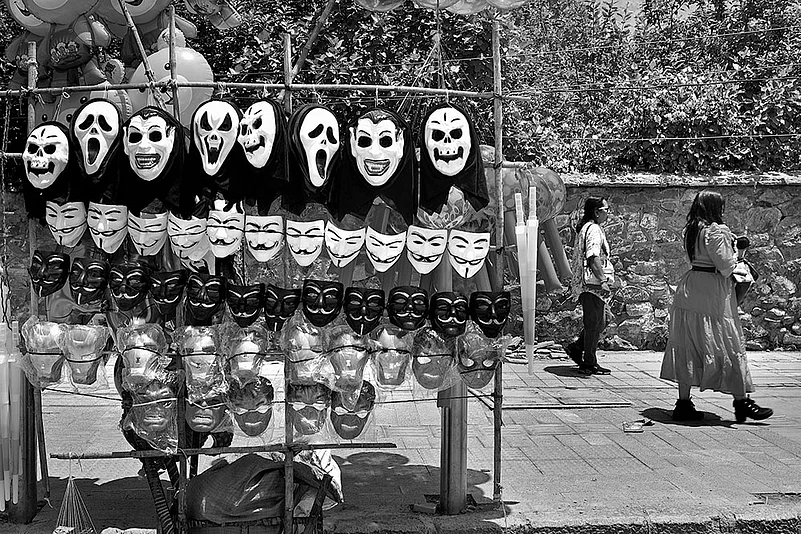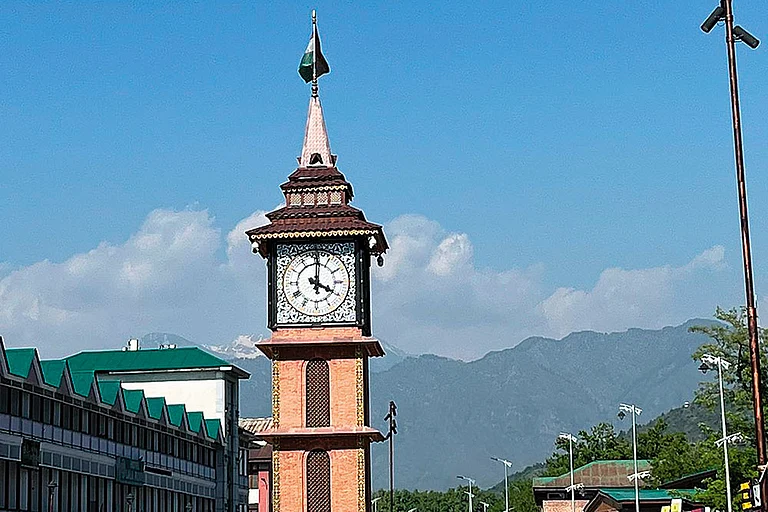Lal Chowk, also known as ‘Red Square,’ derived its name from Communist enthusiasts in the 1930s, who were inspired by Moscow’s iconic Red Square. Located in the heart of Srinagar, the Square is renowned for its clock tower, constructed by Bajaj Electronics in the 1980s. Over the years, it became iconic as Srinagar’s ‘ground zero’ for protests and flag hoisting by proponents of various political ideologies.
Post-abrogation of Article 370, Lal Chowk, once a protest hotspot, now draws hundreds of tourists daily for selfies and relaxation, a stark contrast to its heavily guarded past.
However, after the abrogation, the square underwent a significant transformation under the Smart City project. The clock tower was remodelled with a distinct Kashmiri touch.
As evening descends, tourists and YouTubers flock to Lal Chowk, showcasing a “happy” Kashmir backdrop with the iconic clock tower. A newfound landmark, it’s now a must-visit alongside Pahalgam and Gulmarg.

A tourist from Bengal shared her excitement: “I heard about Lal Chowk from the media and decided to see it for myself. It’s amazing to witness the tower (in person).”
Despite its evolving image, heavy security around Lal Chowk underscores the government’s stance on safety, hinting at the region’s lingering unpredictability.
On May 3, addressing a rally in Uttar Pradesh, Union Home Minister Amit Shah said, “Srinagar’s Lal Chowk, which was virtually out of bounds once, now witnesses Krishna Janmashtami processions as our Tricolour flutters proudly there. This is all due to (Prime Minister Narendra) Modi’s magic. From Kashmir to Kerala, he has ended terrorism.”
Addressing rallies in Prayagraj and Jaunpur, Shah highlighted the transformed situation in Jammu and Kashmir, noting that a ‘Shobha Yatra’ of Lord Krishna now takes place at Lal Chowk, previously a site for military-escorted flag hoisting.
Around Lal Chowk, in areas like Rajbagh, new hotels and guesthouses have emerged, showcasing Kashmir’s tourism boom. Srinagar’s old city is promoted as a heritage destination, with stone-throwing incidents becoming rare. Hotels along the boulevard are fully booked through August, indicating high demand. Border tourism is gaining traction, attracting visitors to the Line of Control (LoC) areas.

Meanwhile, far away from the Valley, enveloped in the rarified air in the heart of the mighty Himalayas, Mohammad Arif, an alpine mountaineer and skier, dove to the depths of his own heart to make a life-altering decision a few years ago.
Arif left behind a stable banking career to pioneer adventure tourism in Kashmir, driven by his vision to showcase its untapped beauty. Now running a successful trekking company, he guides tourists through once-restricted areas like the Shamsbari range and Pir Panjal mountains, witnessing improved accessibility since 2022.
“The government has opened areas close to the LoC, like Keran, Machil, Lolab, Teetwal and Z Gali, for tourists,” says Arif. Just a few years ago, these places—often referred to in military terminology as Keran Sector and Machil Sector—were known for infiltration and frequent and often competitive shelling exchanges between Indian and Pakistani forces.
In 2020 alone, there were 5,100 incidents of ceasefire violations, an all-time high, resulting in the deaths of 36 people and injuries to 130 others.
However, on February 25, India and Pakistan’s DGsMO (Director Generals of Military Operations) issued a joint statement emphasising the importance of achieving lasting peace along the borders. They agreed to address core issues to prevent violence and committed to strict adherence to ceasefire agreements effective from midnight on February 24-25, 2021.
Since the ceasefire agreement, the LoC and the international border areas have remained peaceful, with a significant reduction in ceasefire violations, as per army sources. However, until February 24, 2021, the Indian Army documented 740 ceasefire violations from the Pakistani side. In 2019, there were over 3,200 instances of violations, with 1,565 occurring after August 2019, post the abrogation of Article 370 and Jammu and Kashmir’s bifurcation.
As the ceasefire agreement was sustained, the United States Institute of Peace reported on its anniversary this year, that the ceasefire along the Line of Control (LoC) “has proven to be the most enduring confidence-building measure between the two countries since 2016 and the most enduring attempted LoC ceasefire in more than a decade.”
The dividends of the ensuing peace are there for all to see.
Regions nestled in the border district of Kupwara, once off-limits, are now welcoming visitors. During a recent trek with American tourists to the Lolab Valley in Kupwara, Arif says he received a lot of support from residents. “We didn’t face any logistical issues because the locals have converted their homes into guesthouses available at reasonable rates,” he states.
Over the past three years, the perception and promotion of tourism in Kashmir have undergone a dramatic transformation. “When I started out, we had to promote tourism ourselves and urge the government to open areas beyond popular destinations,” Arif recalls. However, he notes that the current administration has been proactive in unlocking the potential of regions close to the LoC, offering new vistas to high-end tourists.
Once a remote and less-visited area, Gurez Valley has transformed into a sought-after tourist destination, drawing adventurers from around the globe. This remarkable change is largely due to aggressive promotion of the Valley by both the government and the Army. “They’ve made these areas accessible and even opened a trek route from Gurez to Pathwan Lakes, which is a five-day trek,” Arif says. “Earlier, you couldn’t have thought about such a thing.”
The contrast between past and present tourism efforts in Kashmir is striking. “This time, the encouragement comes from the highest levels of government, from the Prime Minister and the Union Home Minister,” Arif adds. “This helps a lot. High-end tourists and foreigners rely heavily on such endorsements when deciding to visit Kashmir.”
The region attracted over 21.1 million tourists in 2023, propelling the economy to new heights, says the state Tourism department.
In addition to Gurez, the authorities have opened the Pir Panjal region from the Yusmarg end in South Kashmir for trekking. Similarly, the Athwatoo area in Bandipora, located in the Shamsbari range once infamous for infiltration routes, is now accessible to tourists. This shift has led high-end Indian tourists to explore beyond traditional spots like Gulmarg, Pahalgam, and Sonamarg.
“Since 2022, we’ve seen a surge in tourism and we no longer need to promote it extensively—tourists now come on their own,” says Nasir Shah, chairman of the Indian Association of Tour Operators-JK Chapter. He claims that around 100 tourists visit Gurez each day. However, the region’s growing popularity has brought about its own challenges. “There are few hotels in Gurez and rooms are fully booked,” Shah adds.
In his Republic Day address this year, Lt Governor Manoj Sinha described tourism as “a way of life for Jammu and Kashmir.” He stated, “This paradise on earth witnessed a record influx of 2.11 crore tourists during the year 2023 and the G20 Summit held in Srinagar in May 2023 led to a 2.5 times increase in the arrival of foreign tourists.”
The government maintains that apart from popular tourist destinations like Gulmarg and Pahalgam, there is a significant influx of tourists in offbeat destinations, with one million visiting Dudhpathri and 0.15 million visiting Lolab Valley in Kupwara. This year, according to tourism officials, more than one million tourists have visited Kashmir till mid-May, with the J&K administration readying for record-breaking tourist numbers this year.
The region attracted over 21.1 million tourists in 2023, propelling the local economy to new heights, according to the state Tourism department. This surge significantly helped the tourism sector recover from the setbacks experienced after the abrogation of Article 370 on August 5, 2019 and the subsequent restrictions imposed during the COVID-19 pandemic in 2020.
The gradual upswing in tourism can be traced back to the mid-1990s when Farooq Abdullah formed the government in 1996 and started developing tourism infrastructure.
Later, Mufti Mohammad Sayeed, during his tenure in 2002 and Ghulam Nabi Azad in 2006, promoted tourism aggressively. By 2012, under Omar Abdullah’s administration, Kashmir saw a significant increase in tourist arrivals. However, the elected governments always remained secretive about tourism numbers and wouldn’t link tourism inflow with normalcy and peace.
The biggest blow to Kashmir’s tourism came just before the abrogation of Article 370. In the days leading up to August 5, 2019, the government issued several orders that created widespread panic. One such order on August 2, 2019, advised all tourists and pilgrims to leave the Valley immediately due to intelligence inputs about potential terror threats specifically targeting the Amarnath Yatra.
This directive, along with the massive deployment of additional paramilitary forces, created the impression of an impending war-like situation. Just three days later, on August 5, 2019, Article 370 was revoked, shocking the Valley’s residents. However, in the past two years, with Kashmir not witnessing strikes and law and order incidents, like stone-throwing, the region is now experiencing what officials describe as a “tourism renaissance.” The current increase in visitors reflects not just a recovery but also provides jobs in the growing hospitality sector.
Tourists are happy too. Ajit Pal Singh, a tourist from Punjab, was at Dal Lake with his son. He says that this is his first visit to Kashmir and that he didn’t hear anything negative about the region in the past week. “I feel safe in Kashmir,” he says, adding that he heard about Article 370 impeding development. “But I feel safe, as people are friendly.”
Another tourist, Khushi Diwidi from Rajasthan, says she had the impression that Kashmir was not safe. She now perceives the presence of security forces in Kashmir as customary, recognising their purpose in ensuring the safety of the populace.
According to Nasir Shah, any incident like the recent attack on tourists in Pahalgam had zero impact on the influx of tourists. “There are two reasons for it; it was taken as just ‘one of those’ incidents by tourists and the media didn’t play it up,” he adds.
Naseer Ganai in Srinagar
(This appeared in the print as 'A New ‘Boom’ In Kashmir')



















